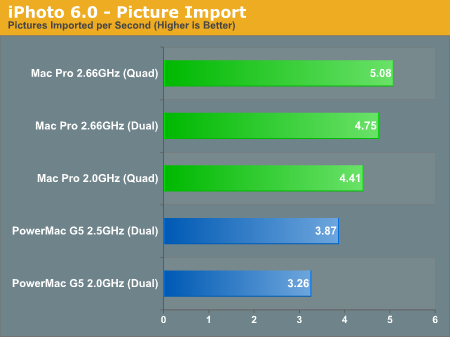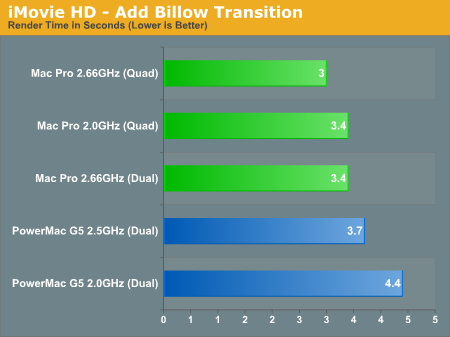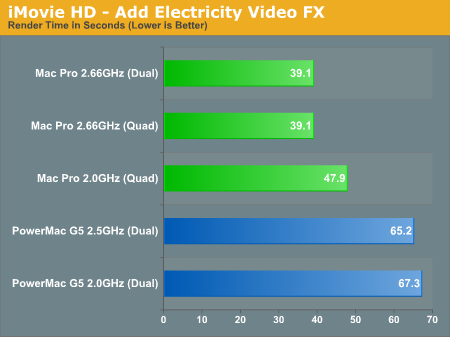Apple's Mac Pro - A True PowerMac Successor
by Anand Lal Shimpi on August 16, 2006 12:27 PM EST- Posted in
- Mac
iLife '06 Performance with iPhoto, iMovie HD and iDVD
One of the benefits of OS X and Apple's application suites is that most of the applications are already properly threaded. Even though you wouldn't expect it, iPhoto is threaded quite well and thus our import photos test gets a speedup from going to quad cores.
The test is simple; we timed the import of 379 photos into iPhoto which, believe it or not, is quite CPU intensive and not as I/O bound as you'd think. After we got the time we divided it into 379 to get the number of pictures imported per second. We included the performance of a hypothetical dual core Mac Pro in addition to the native quad offerings in order to provide a good point of comparison to the dual processor PowerMac G5s.

Although there's a slight performance boost when going from dual to quad core (6.9%), this test is largely dependent on clock speed within a single microprocessor architecture. Comparing the Woodcrest based Xeons to the older G5s is no contest, at 2.0GHz the Mac Pro is already 14% faster than the 2.5GHz PowerMac G5; even if we account for the dual vs. quad core comparison, the 2.0GHz Mac Pro is still noticeably faster than the G5.
The next application we looked at was iMovie HD. There are two primary focuses for performance in iMovie HD, video import speed (if you are dealing with a non-DV or non-iSight video source) and effect rendering speed. We focused on the latter, measuring the time it takes to render the most CPU intensive transition and video effect in iMovie HD.

Our Macs have gotten a little too fast for the billow transition test, as the Mac Pro 2.66GHz can now complete the test in 3 seconds flat. All of the Mac Pros here are faster than the PowerMac G5s, which is what we'd expect given what we learned in the iMac Core Duo vs. iMac G5 article.

Rendering the "Electricity" Video FX sees no benefit going from dual to quad cores, but the Mac Pro doesn't need it as the 2.0GHz configuration is already 26.5% faster than the PowerMac G5 2.5GHz.
Finally we've got iDVD, an application that you can use to create DVDs that are playable on any consumer DVD player. There are once again two aspects to performance in iDVD, video encoding performance and menu encoding performance. Since we've already looked at video encoding performance with Quicktime, this test is predominantly limited by how long it takes to encode the menu system in our test DVD. There is a small 13 second iSight video and audio that's encoded in the process but it adds a matter of seconds to the overall time. The image is written to disc instead of sent to the DVD burner for obvious reasons. The results are expressed in seconds, lower being better. This workload is multithreaded.

The benchmark gets just under 11% thanks to the 4 cores in the Mac Pro, but even without them the Mac Pro 2.66GHz is able to outperform the PowerMac G5 2.5GHz by just under 13%. The Xeon seems to scale much better with clock speed in this test than the G5.










96 Comments
View All Comments
rockinphotog - Saturday, August 19, 2006 - link
AS a matter of fact, I often use my apple keyboard for my digital camera, printer, syncing my treo and even my wacom tablet.aaronlyon - Friday, August 18, 2006 - link
In next week's article, please evaluate Parallels Workstation for running Windows apps simultaneously with Mac OS. If this works smoothly, why not use Windows versions of Adobe Photoshop and Illustrator? That would be a good solution while waiting for Universal Binary updates.Zebo - Friday, August 18, 2006 - link
Great pics and article Anand.What a deal for such a clean system. They don't build PCs that pretty and this is the best yet from Apple's industrial design squad. I definity want one but don't need four cores.
Can I run Windows fully with this machine? Or maybe I should wait until a single processor (dual core) version comes. If Apple sells $1500 Conroe boxes and it ran windows they counld'nt keep them in stock.
plinden - Friday, August 18, 2006 - link
There's an issue with the speed of SATA hard drives, as Anand mentions here: http://www.anandtech.com/weblog/default.aspx#287">http://www.anandtech.com/weblog/default.aspx#287
It will probably be fixed eventually but if you're relying on this to run Windows, you should wait.
FutureMedia - Thursday, August 17, 2006 - link
You are not comparing the Quad G5 Rear Ports to the Mac Pro Rear Ports. Quad G5 has 3 USB 2 ports as well as 2 Gigabyte Ethernet ports just like the Mac Pro. IE the Quad G5 rear set of ports is IDENTICAL to the Mac Pro rear set - just laid out differently. Only the front adds a fifth USB 2 and second FW800 port not on the Quad G5 which is the same layout as what you show from OLDER not last generation October 2005 PowerMac G5s.Moreover I was looking forward to a Quad G5 comparison with the 2GHz and 2.66 GHz Mac Pros. That is what I want to know. Especially Is even the 2GHz Mac Pro faster than the Quad G5? Is the problem that you don't have a Quad G5 in house to compare it to? I am so bummed out that you didn't compare Mac Pro two bottom speeds with the Quad G5. Please can you do it after next week? I would really appreciate it. Thanks.
PhilG5 - Friday, August 18, 2006 - link
Thank you so much for pointing that out! In fact, Anandtech uses mid-2004 PowerMac G5 (still using AGP graphics and DDR-400 memory!) and doesn't take into account the whole "late 2005" series (which first supported DDR2, PCI-E and had the "Antares" PPC970 core). If you look at Barefeats benchmark results ( http://barefeats.com/quad06.html">http://barefeats.com/quad06.html ) the Quad G5 still seems to be pretty much competitive with the new Mac Pros.Anand Lal Shimpi - Friday, August 18, 2006 - link
We did not have a Quad G5 on hand, however the performance results woult not have been that different. The benchmarks that show little or no scaling between the Dual and Quad Mac Pros would show the same scaling between dual and quad G5s (which were most of the benchmarks). None of our tests were GPU bound, so difference in graphics interfaces should also minimally impact performance. The only real variable that could have changed things is DDR2, however seeing as how none of the DDR-DDR2 transitions we've seen on the PC side have done anything for performance, hopes aren't too high for a tremendous impact on G5 performance.Take care,
Anand
Konq - Thursday, August 17, 2006 - link
Anand - I think something is wrong with the 2 vs. 4 core Xcode test. As with gcc, you can tell it to compile with as many threads as you like. This will compile 4 source files at the same time for instance on 4 cores (multitasking). Perhaps the code was too small to really see a difference, or the environment was not set right?Konq - Saturday, August 19, 2006 - link
OK, now another interesting 4-core note: MacWorld did a test with iTunes and a quad core, 2.5 Ghz G5 beat a dual-core, 2.7 Ghz G5 system when converting 45 minutes of AAC files to mp3. Maybe this was due to having multiple files to work on? AAC->mp3 vs. Wave->mp3?One thing I am interested in now: An article that covers how to get the most out of 4-core systems. Which software benefits and how. Since 4-core processors are coming out soon, this will be needed in purchasing decisions.
Konq - Friday, August 18, 2006 - link
I verified on the Apple Xcode users list that Xcode can indeed take advantage of every core. You might want to modify the test you do and configuration if needed.Great article btw. I enjoy reading reviews from you that can be counted on for true pro's and con's instead of overly rosey approach from fan sites.
In spite of "horrid memory system", it sounds like the system kicks butt! One is in my future...